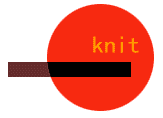
|
|
|
page
1
|
selected information |
|
The story of Knitting in Japan Part 1
Up to the Meiji Period |
As a Japanese knitter who lives mainly outside Japan I often get asked questions like: ..is there a history of knitting in Japan? In this series of articles, of which this is Part One, I will attempt to answer these questions. Part One of this series covers the first contacts with knitting in Japan, up to the end of the ‘Edo’ period in 1867 |
||||
|
How Knitting came to Japan Before I start, I need to make one thing clear: I am not a historian or an authority on the history of knitting, so I am relying on a few limited sources. Although it would be absurd to suggest that knitting in Japan forms as deep a part of our historical culture as it does in Europe and the Middle East, knitting has been around there a bit longer than you might think. According to the ‘History of Knitting’ (Richard Rutt, Interweave Press 1991) , there was no word meaning knitting in Ancient Greek and it wasn’t until the Medieval period that words for knitting began to circulate : ‘knitting’ in English, ‘tricot’ in French, ‘strikke’ in German and ‘maglia’ in Italian. It seems that historians disagree on how exactly to apply the term when looking at ancient artefacts. Sometimes the term is used extremely loosely to describe a variety of early textile techniques, even although they bear only a fleeting resemblance to what we think of as knitting. It is certainly a grey area, and, unfortunately, some of the writers I quote from later use the term with varying degrees of precision. Before the Europeans |
|||||
|
‘Amimono ima mukashi’ (Knitting
Today & Past) - Yoshihiro Matushita, 1986, published by Nihon Vogue,
provides an introduction to the history of knitting in Japan, largely
from the perspective of the development of knitting yarn manufacturers.
Most of this article is drawn from this source. Mr Matushita briefly
covers some ancient textile relics that he considers to be connected
to knitting |
The Jomon period, extended from 10,000 BC – 500 or 400 BC. Amazingly there are some Jomon textile fragments, such as the baskets and other items made from plants unearthed at the Aomori prefecture, that are still in existence. Matushita describes these as ‘knitted’, by which I think he means, generally, ‘knotted’ or ‘netted’. I suspect the technique may be more like 'naalbinding'. |  |
|||
| Other Japanese experts also use the term knitting when describing very recent discoveries in the Karinba-3 ruins at Eniwa on Hokkaido, Japan's northernmost island. Fabric traces were found on a red-lacquered comb that are believed to be silk, and within this there is a pattern of holes that Yasushi Kosugi, Assistant Professor of Archaeology at Hokkaido University, think is the remains of some kind of knitting. Similar objects have been found from the Yayoi period (500 or 400 BC – 300 AD). | |||||
 |
Shosoin Treasure House, established 760 AD |
Shosoin is an ancient wooden building on the site of Todai-ji temple in Nara that houses over 9,000 examples of Far Eastern antiquities from the 7th-8th centuries. In their collection are interesting ink drawings on linen and also on mirror frames that show fishing nets. |
|||
| >> page 2 | |||||